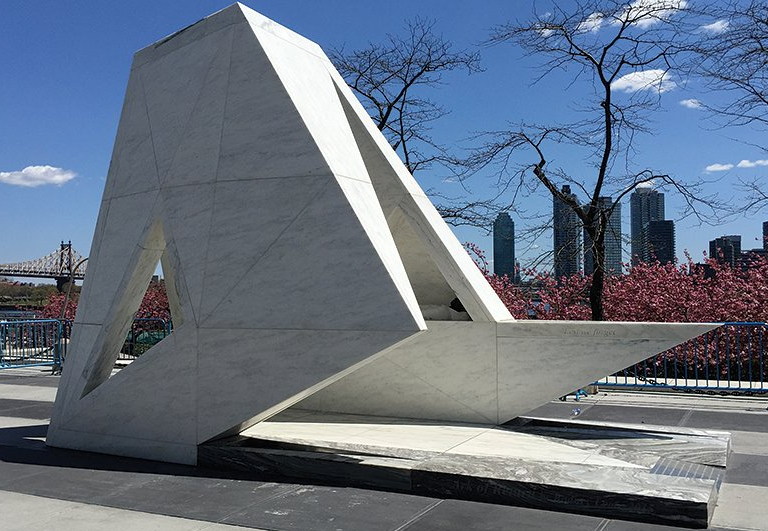The Ark of Return
The Ark of Return memorial is a sacred space that is designed to psychologically and spiritually transport visitors to a place where acknowledgement, education, reflection and healing can take place. The memorial's exterior form is constructed in a fashion to reflect the image of a vessel or ship in acknowledgement of the millions of African people transported on slave ships to different parts of the world during the "Middle Passage." Images of maps depicting the "Triangular Slave Trade" influenced the use of the triangle as a primary element in designing the memorial's shape. The memorial is conceptually also organized in three parts and visitors are meant to pass through "The Ark of Return" to intimately experience three primary elements on the interior space.[1]
In 2011, together with UNESCO the Permanent Memorial Committee launched a design competition. "The Ark of Return" by Haitian-American architect Rodney Leon was chosen among 310 entries from 83 countries.[2]
Location : United Nations Visitors Plaza
1st Avenue and 46th Street
New York, NY 10017[3]
History
For over 400 years, more than 15 million men, women and children were the victims of the tragic transatlantic slave trade, one of the darkest chapters in human history.
Every year on 25 March, the International Day of Remembrance for the Victims of Slavery and the Transatlantic Slave Trade offers the opportunity to honour and remember those who suffered and died at the hands of the brutal slavery system.
In order to more permanently honour the victims, the Permanent Memorial has been erected at United Nations Headquarters in New York. The unveiling took place on 25 March 2015. The memorial invites people everywhere to contemplate the legacy of the slave trade and to fight against racism and prejudice today.[4]
Background
Designed by Rodney Leon, an American architect of Haitian descent, the Permanent Memorial titled The Ark of Return was unveiled on 25 March 2015. This design was selected through an international competition organized in partnership with UNESCO and announced in 2013. It will stand as a constant reminder of the courage of slaves, abolitionists and unsung heroes who helped end the oppression of slavery. It will also promote greater recognition of the contributions that slaves and their descendants have made in their societies.
The triangular patterns are reminiscent of the triangular route of the slave trade which existed between the continents. The exterior form reflects the image of a vessel or ship in acknowledgement of the millions of African people who were transported on slave ships to different parts of the world. The white colour recalls African spirituality. In times of death, sorrow, and reflection, white attire is considered to be the most appropriate.
The title The Ark of Return is a deliberate contrast to the Door of No Return through which enslaved Africans were deported to the Americas. The Door of No Return is located in the “House of Slaves”, a museum and memorial on Gorée Island, Senegal. It is believed to have been the location of the largest slave-trading centre on the African coast. In 1978, the island was added to UNESCO’s World Heritage List and serves as a reminder of human exploitation and as a sanctuary for reconciliation.[5]
Monument Section
The Memorial contains three main elements, including:
- FIRST ELEMENT: “Acknowledge of the tragedy” is a three dimensional map inscribed on the interior of the memorial. This map highlights the African continent at the centre of the slave trade and illustrates the global scale, complexity and impact of the triangular slave trade.
- SECOND ELEMENT: “Consider the legacy” features a full-scale human replica carved out of black Zimbabwean granite. This element illustrates the extreme conditions under which millions of African people were transported during the middle passage. The sculpture represents the spirit of the men, women and children who lost their lives in the transatlantic slave trade.
- THIRD ELEMENT: “Lest we forget” is a triangular reflecting pool whMission can honour the memory of the millions of souls that were lost.[6]
Mission
The Permanent Memorial will serve as a reminder of the legacy of the slave trade. It will provide future generations an understanding of the history and consequences of slavery and serves as an educational tool to raise awareness about the current dangers of racism, prejudice and the lingering consequences that continue to impact the descendants of the victims today.
The Permanent Memorial acknowledges one of the most horrific tragedies of modern history. It is a reminder of the heroic actions of the slaves, abolitionists and unsung heroes who acted in the face of grave danger and adversity.
The Memorial's placement at United Nations Headquarters is a significant symbol of what the world body represents: the promotion and preservation of the dignity and worth of all human beings - principles that are central to its Charter.[7]
Reference
- ↑ The Ark of Return. Rodneyleon.com. Retrieved February 1, 2021
- ↑ A MEMORIAL TO HONOUR THE VICTIMS OF SLAVERY "THE ARK OF RETURN". Teterevufonds.lv. Retrieved February 1, 2021
- ↑ International Day for Remembrance of the Slave Trade and its Abolition. Unesco.org. Retrieved January 31, 2021
- ↑ A MEMORIAL TO HONOUR THE VICTIMS OF SLAVERY "THE ARK OF RETURN". Teterevufonds.lv. Retrieved February 1, 2021
- ↑ The Ark of Return.Un.org. Retrieved February 1, 2021
- ↑ International Day for Remembrance of the Slave Trade and its Abolition. Unesco.org. Retrieved January 31, 2021
- ↑ Permanent Memorial to Honour the Victims of Slavery and the Transatlantic Slave Trade at the United Nations.Un.org. Retrieved February 1, 2021


